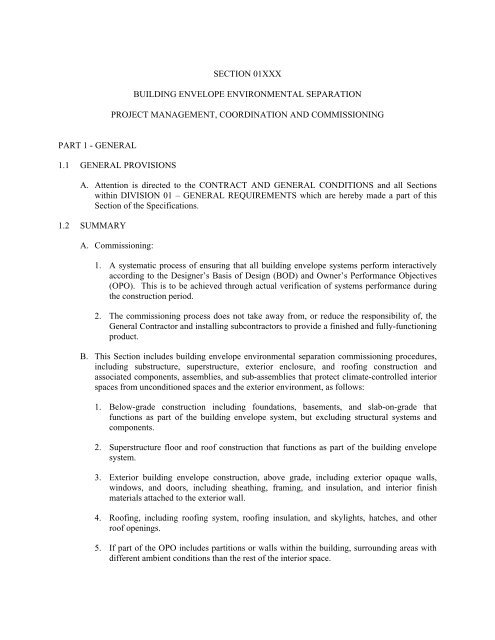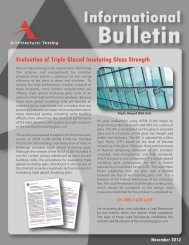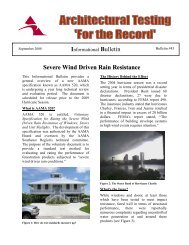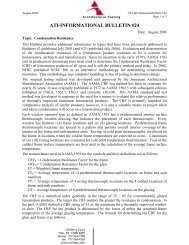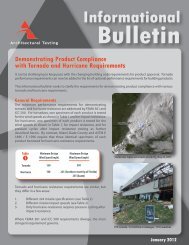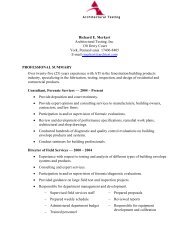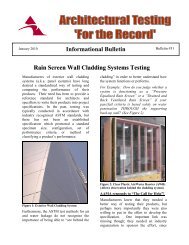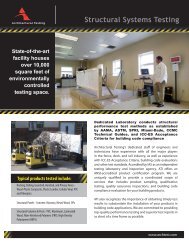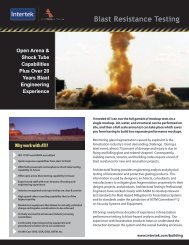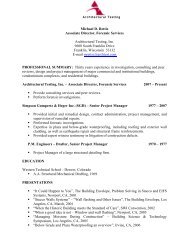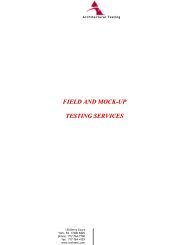Commissioning Specifications - Architectural Testing
Commissioning Specifications - Architectural Testing
Commissioning Specifications - Architectural Testing
You also want an ePaper? Increase the reach of your titles
YUMPU automatically turns print PDFs into web optimized ePapers that Google loves.
SECTION 01XXX<br />
BUILDING ENVELOPE ENVIRONMENTAL SEPARATION<br />
PROJECT MANAGEMENT, COORDINATION AND COMMISSIONING<br />
PART 1 - GENERAL<br />
1.1 GENERAL PROVISIONS<br />
A. Attention is directed to the CONTRACT AND GENERAL CONDITIONS and all Sections<br />
within DIVISION 01 – GENERAL REQUIREMENTS which are hereby made a part of this<br />
Section of the <strong>Specifications</strong>.<br />
1.2 SUMMARY<br />
A. <strong>Commissioning</strong>:<br />
1. A systematic process of ensuring that all building envelope systems perform interactively<br />
according to the Designer’s Basis of Design (BOD) and Owner’s Performance Objectives<br />
(OPO). This is to be achieved through actual verification of systems performance during<br />
the construction period.<br />
2. The commissioning process does not take away from, or reduce the responsibility of, the<br />
General Contractor and installing subcontractors to provide a finished and fully-functioning<br />
product.<br />
B. This Section includes building envelope environmental separation commissioning procedures,<br />
including substructure, superstructure, exterior enclosure, and roofing construction and<br />
associated components, assemblies, and sub-assemblies that protect climate-controlled interior<br />
spaces from unconditioned spaces and the exterior environment, as follows:<br />
1. Below-grade construction including foundations, basements, and slab-on-grade that<br />
functions as part of the building envelope system, but excluding structural systems and<br />
components.<br />
2. Superstructure floor and roof construction that functions as part of the building envelope<br />
system.<br />
3. Exterior building envelope construction, above grade, including exterior opaque walls,<br />
windows, and doors, including sheathing, framing, and insulation, and interior finish<br />
materials attached to the exterior wall.<br />
4. Roofing, including roofing system, roofing insulation, and skylights, hatches, and other<br />
roof openings.<br />
5. If part of the OPO includes partitions or walls within the building, surrounding areas with<br />
different ambient conditions than the rest of the interior space.
C. Related Sections:<br />
1. Division 01 Section "General <strong>Commissioning</strong> Requirements" for general requirements for<br />
commissioning, including definitions, commissioning team membership, Owner’s<br />
responsibilities, Contractor’s responsibilities, and <strong>Commissioning</strong> Authority’s<br />
responsibilities.<br />
2. Division 03 through 14 Sections for building envelope commissioning requirements<br />
specific to the Work of each Section.<br />
1.3 COMMISSIONING TEAM<br />
A. Owner and his/her Consultants.<br />
B. General Contractor.<br />
C. Designer and design engineers.<br />
D. Building Envelope <strong>Commissioning</strong> Authority (BECA).<br />
E. Building envelope subcontractors and their subcontractors.<br />
F. Specialty subcontractors (insert other relevant trades where applicable).<br />
G. Any other installing subcontractors or suppliers of materials or systems.<br />
1.4 BUILDING ENVELOPE COMMISSIONING AUTHORITY<br />
A. The Provide a Building Envelope <strong>Commissioning</strong> Authority (BECA) to oversee the<br />
commissioning of all building envelope components.<br />
B. The BECA shall be approved and engaged by the Owner at the time of Basis-Of-Design, and<br />
shall be provided for the Project until all building systems have been accepted by both the<br />
Designer and the Owner.<br />
C. The BECA shall have, at a minimum, 10 years experience in the practices that encompass<br />
building envelope commissioning, including understanding systems design intent, performing<br />
architectural and shop drawing peer reviews, evaluating submittal compliance, administering<br />
preconstruction meetings, performing/supervising field performance testing, fulfilling field<br />
construction administration responsibilities, evaluating component/assembly compliance and<br />
performing forensic evaluations, as relating to Divisions 03 through 14 Sections for building<br />
envelope commissioning requirements specific to the Work of each Section.<br />
D. The BECA shall be accredited by the International Accreditation Services, Inc. (IAS) and<br />
American <strong>Architectural</strong> Manufacturers Association (AAMA) in accordance with ISO/IEC<br />
17025 (International Standards Organization) for the test methods used in the building envelope<br />
commissioning process. If the BECA does not meet these requirements, a subcontractor or<br />
vendor responsible for testing under the direction of the BECA must satisfy these same<br />
requirements.
E. The BECA cannot be financially associated with any of the Division 01 through 14 contractors<br />
or vendors prior to engaging in this contract.<br />
1.5 COMMISSIONING AUTHORITY'S RESPONSIBILITIES<br />
A. Meet with Owner to establish OPO, and Architect to determine BOD.<br />
B. Review project drawings and specifications at 25%, 50%, and 100% completion for<br />
constructability, curability, performance, and building envelope conformance.<br />
C. Review shop drawings, product data, and samples for compliance with Contract Documents.<br />
D. Write project specific commissioning plan.<br />
E. Review coordination drawings.<br />
F. Provide project-specific construction checklists and commissioning process test procedures.<br />
G. Participate in all project meetings, including design, preconstruction, and construction phase<br />
meetings.<br />
H. Witness systems, assemblies, equipment, and component start-up.<br />
I. Perform or facilitate mock-up performance testing.<br />
1. Document construction of commissioning components at the completion of mock-up<br />
testing.<br />
J. Review proposals and requests for substitutions and changes for compliance with Contract<br />
Documents, and for compatibility with Work of other subcontractors.<br />
K. Review building envelope work for compliance with Contract Documents.<br />
1. Maintain list of observed deficiencies and discrepancies.<br />
2. Develop protocols for functional performance testing.<br />
i. Develop schedules for all testing, and integrate testing into master construction<br />
schedule.<br />
3. Perform or facilitate functional performance testing,<br />
L. Compile test data, inspection reports, and certificates and include them in the systems manual<br />
and commissioning process report.<br />
M. Ensure that building envelope systems, subsystems, and construction have been completed<br />
according to the Contract Documents.<br />
N. Issue letter of compliance, assuming all non-compliant items are addressed.
1.6 CONTRACTOR'S RESPONSIBILITIES<br />
A. Attend pre-construction and construction-phase building enclosure coordination meetings.<br />
B. Provide schedule and perform field quality control tests and inspections required by the<br />
Contract Documents to the BECA.<br />
C. Submit field quality control testing and inspection reports on building envelope construction to<br />
the BECA.<br />
D. Submit operation and maintenance data for systems, subsystems, and components to the BECA.<br />
E. Provide cut sheets and shop drawing submittals of commissioned systems to the BECA.<br />
F. Provide input for final commissioning documentation to the BECA.<br />
G. Participate in testing/inspection procedures meetings.<br />
H. Provide complete set of Coordination Drawings showing the complete coordination and<br />
integration of all Work of commissioned systems to the BECA.<br />
I. Permit BECA to access locations of installed systems, subsystems, assemblies, and components<br />
for testing and inspection.<br />
J. Reimburse Owner for non-compliant tests and inspections as outlined in Division 01 through<br />
14.<br />
K. Provide test data, letters of compatibility, and certificates to BECA as required.<br />
L. Participate in maintenance orientation and inspection.<br />
M. Participate in operation and maintenance training sessions.<br />
N. Address current Owner and Designer punchlist items.<br />
O. Participate in final review at acceptance meeting.<br />
1.7 DESIGNER/DESIGN ENGINEER RESPONSIBILITIES<br />
A. Submit all Record Documents to BECA including:<br />
1. Electronic [-and paper] copies of all project Drawings, including title sheet, code analysis,<br />
architectural, and shop drawings.<br />
2. All <strong>Specifications</strong> in PDF [-and paper] format with addenda.<br />
3. Shop drawings and product cuts, scanned in, approved sheets only.<br />
4. Project schedules baseline and all updates.<br />
B. Provide written responses to design review comments from the BECA or other parties as<br />
requested.
C. Attend design, pre-construction, and construction phase coordination meetings.<br />
D. Participate in testing procedures meetings.<br />
E. Provide resolution for items for which the BECA and Contractor may be in disagreement.<br />
1.8 COMMISSIONING DOCUMENTATION<br />
A. Provide the following information to BECA for inclusion in the <strong>Commissioning</strong> Plan:<br />
1. Submittals, information for systems manuals, and other required documents and reports.<br />
2. Identification of installed building envelope components, assemblies, systems, and<br />
equipment, including design changes that occurred during the construction phase.<br />
3. Certificate of completion, certifying that building envelope assemblies, systems,<br />
equipment, and associated controls are complete and ready for testing.<br />
4. Test and inspection reports and certificates.<br />
5. Corrective action documents.<br />
B. The BECA will provide regular reports to the Owner, and distribute to other parties as<br />
requested by the Owner, as construction and commissioning progresses.<br />
C. A final summary report (including back-up documentation) and letter of compliance will be<br />
provided by the BECA to the Owner upon completion of building envelope construction and<br />
resolution of unaddressed non-compliant items. All acquired documentation, logs, minutes,<br />
reports, deficiency lists, communications, findings, unresolved issues, etc., will be compiled in<br />
appendices and provided with the summary report.<br />
1.9 MEETINGS<br />
A. Scoping Meeting: The BECA shall schedule, plan, and conduct a commissioning scoping<br />
meeting with the entire commissioning team in attendance. Meeting minutes will be distributed<br />
to all parties by the BECA.<br />
B. Pre-Construction <strong>Commissioning</strong> Conference: The General Contractor will schedule a preconstruction<br />
commissioning conference prior to the commencement of construction of the<br />
building envelope, at a time convenient to the Owner, BECA, Contractor and subcontractors,<br />
and Architect. Allow for the conference to be held at Project site or another convenient<br />
location. The <strong>Commissioning</strong> Authority will conduct the meeting to review commissioning<br />
responsibilities and personnel assignments.<br />
1. Attendees: Owner, BECA, Architect and consultants, General Contractor, building<br />
envelope subcontractors, and other relevant parties shall attend the conference.<br />
2. General Contractor will record and distribute meeting minutes.
3. Agenda: Topics to be discussed during the meeting shall include, but not be limited to, the<br />
following:<br />
i. <strong>Commissioning</strong> Plan and related specifications.<br />
ii. Construction schedule for General Contractor and building envelope subcontractors.<br />
iii. Phasing.<br />
iv. Review of project plans and specifications.<br />
v. Review of contractor shop drawings.<br />
vi. Construction sequencing.<br />
vii. Designation of key personnel and their duties.<br />
viii. Construction and testing of mock-ups.<br />
ix. Inspection and testing protocols, procedures, and test methods.<br />
x. Submittal procedures.<br />
xi. LEED requirements (if applicable).<br />
xii. Preparation of Record Documents.<br />
xiii. Owner’s occupancy requirements.<br />
xiv. Security.<br />
C. Miscellaneous Meetings: Other meetings will be planned and conducted by the BECA as<br />
construction progresses. These meetings will cover coordination, deficiency resolution, and<br />
planning issues with particular contractors and their subcontractors. The BECA will plan these<br />
meetings and will minimize unnecessary time being spent by contractors and subcontractors.<br />
These meetings will be held as required.<br />
1.10 PRE-CONSTRUCTION TESTING<br />
A. Refer to Section 1.12 below for commissioning procedures governing mock-ups and phased<br />
mock-up testing.<br />
B. Refer to Division 03 through 14 Sections for mock-up requirements specific to the Work of<br />
each Section.<br />
1.11 QUALITY ASSURANCE<br />
A. Quality Assurance and Control: Specific commissioning quality assurance and quality control<br />
requirements for individual construction activities are specified in the Sections that specify<br />
those activities. Specified commissioning tests, inspections, and related actions do not limit<br />
Contractor's other quality assurance and quality control procedures that facilitate compliance<br />
with the Contract Document requirements.<br />
1.12 FUNCTIONAL PERFORMANCE TESTING<br />
A. Objectives and Scope: The objective of functional performance testing is to demonstrate that<br />
each building envelope assembly/system is functioning according to the documented design<br />
intent of the Contract Documents and in accordance with the OPR. Functional testing<br />
facilitates bringing the material assembly from a state of substantial completion (or completed<br />
to facilitate pre-testing) to full operation. Additionally, during the testing process, areas of noncompliant<br />
performance are identified and corrected, improving the operation and functioning of<br />
the building envelope/assemblies.
B. Development of Test Procedures: Before specific test protocols and procedures are developed,<br />
the BECA will request all documentation and a current list of change orders affecting building<br />
envelope/assemblies, including an updated points list and parameters. The BECA shall develop<br />
specific test protocols and procedures to verify and document proper operation of each piece of<br />
building envelope/assemblies.<br />
C. Functional Performance <strong>Testing</strong>: All functional performance testing of building<br />
envelope/assemblies shall be performed by the BECA, unless otherwise specified by the<br />
BECA. Any subcontractor or vendor responsible to execute a test shall provide assistance to<br />
the BECA in developing the procedures review (answering questions about assemblies and<br />
sequences, etc.). Prior to execution, the BECA will provide a copy of the test procedures to the<br />
General Contractor and subcontractor(s) who will review the tests for feasibility, building<br />
envelope/assemblies, and warranty protection.<br />
D. Test Methods:<br />
1. A mock-up test[s] must be included to verify component and assembly performance prior<br />
to commencing with construction or during the first phase of construction. Refer to Section<br />
019115, 1.8 PRE-CONSTRUCTION TESTING.<br />
2. Functional performance testing and verification may be achieved by manual testing<br />
(persons manipulate the equipment and observe performance). The BECA may substitute<br />
specified methods or require an additional method to be executed, other than what was<br />
specified. The BECA will determine which method is most appropriate for tests that do not<br />
have a method specified.<br />
3. Simulated Conditions: Simulating conditions (not by an overwritten value) shall be<br />
allowed, though timing the testing to experience actual conditions is encouraged wherever<br />
practical.<br />
E. Sampling: Multiple identical pieces of assemblies may be functionally tested using a sampling<br />
strategy. Significant application differences and significant sequence of functional differences<br />
in otherwise identical materials or assemblies invalidates their common identity. A small size<br />
or capacity difference, alone, does not constitute a difference. It is noted that no sampling by<br />
contractors and their subcontractors is allowed in pre-functional checklist execution.<br />
F. The Contractors and their subcontractors shall provide sufficient notice to the BECA regarding<br />
their completion schedule for the construction of the assemblies or exterior enclosure systems.<br />
The BECA will schedule functional tests through the General Contractor.<br />
G. The BECA shall perform/administer and document the results of all functional performance<br />
tests.<br />
H. If tests cannot be completed because of a deficiency outside the scope of the building envelope,<br />
the deficiency shall be documented and reported to Owner. Deficiencies shall be resolved and<br />
corrected by Contractor and tests rescheduled.<br />
I. The BECA may recommend solutions to problems found; however, the burden of responsibility<br />
to solve, correct, and retest problems is with the General Contractor, subcontractors and their<br />
sub-subcontractors and the Designer.
1.13 NON-CONFORMANCE<br />
A. All deficiencies or non-conformance issues shall be noted and reported by the BECA to the<br />
General Contractor and Designer.<br />
B. Corrections of minor deficiencies identified during functional performance testing or<br />
inspections may be made at the time of testing/inspection at the discretion of the BECA. In<br />
such cases, the deficiency and resolution will be documented.<br />
C. Failure Due to Manufacturer Defect: If of identical pieces (size alone does<br />
not constitute a difference) of materials or assemblies fail to perform to the Contract<br />
Documents (physically or substantively) due to manufacturing defect, not allowing it to meet its<br />
submitted performance spec, all identical units may be considered unacceptable by the General<br />
Contractor, subcontractor, sub-subcontractor, BECA, Designer or Owner.<br />
PART 2 - PRODUCTS<br />
Not Used<br />
PART 3 – EXECUTION<br />
Not Used<br />
END OF SECTION


